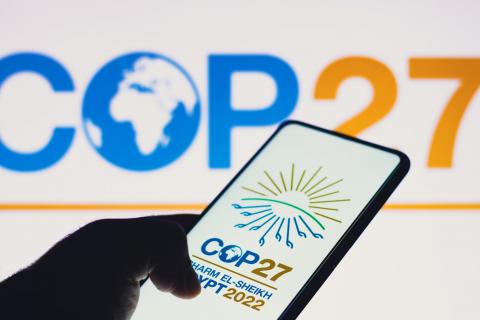Reactions to the results of the Global Carbon Budget 2022 report
The Global Carbon Project (GCP) today releases its Global Carbon Budget 2022 report. The main conclusion is that there is no sign of a decrease in global CO2 emissions and, at current levels, there is a 50 % chance of exceeding 1.5°C warming in nine years. The results will be published in the journal Earth System Science Data.

Pixabay.
Vanesa Castán - Global Carbon Budget EN
Vanesa Castán Broto
Professor of Urban Climate Change at the University of Sheffield
The results of the Global Carbon Budget 2022 are bleak. The report explains that carbon emissions are continuing to rise, and that, if this continues, it will lead to an increase in global average temperature to above the 1.5°C limit in just 9 years. This limit is significant because it indicates that climate change will reach a very destructive stage in a single decade. As the IPCC explained in the AR6 Working Group II report, published in February 2022, every small temperature increase reduces our ability to adapt to climate change.
However, this report does not demonstrate a total lack of action on climate change. Indeed, there is widespread interest in responding to climate change and there is evidence of responses from the public and private sectors, and from NGOs, community organisations and individuals. These efforts, however, are not enough. In my opinion, these voluntary efforts must be accompanied by agreements to regulate the use of fossil fuels, especially at the global level.
The Global Carbon Budget data is on a positive note, because it shows that progress on the path to zero-carbon is possible in regions such as China and the European Union. The International Energy Agency has also recently published the 2022 World Energy Outlook, which explains that renewables are still on the rise. However, data from countries such as the United States are less optimistic and show the need, once again, for a global partnership to tackle one of the biggest problems of our generation.
Fernando Valladares - GCB 2022 EN
Fernando Valladares
PhD in Biology, CSIC researcher and associate professor at the Universidad Rey Juan Carlos de Madrid
The Global Carbon Project 2022 paper by Friedlingstein et al. represents one of the most comprehensive studies of trends and sources of greenhouse gas emissions detected in recent decades, with a valuable analysis of recent trends in the aftermath of the covid-19 pandemic and so far in 2022. The work is the result of an extensive collaboration of top scientists involved in energy, emissions and climate modelling. The study finds no evidence that emissions have declined in recent decades. The main findings highlight that the pandemic has been a very brief hiatus in the trend of annual emission increases, which have skyrocketed more than ever after confinement. This makes the target of no more than 1.5°C of warming compared to the pre-industrial era agreed at the 2015 COP in Paris increasingly unattainable.
Analysis of the major emitting countries shows that the large increase in coal consumption and emissions generation is due to China, while the increases in emissions in the United States and the European Union are mainly due to increased use of gas. Oil remains the most important source of emissions and dominates global growth in fossil fuel use.
The terrestrial carbon sink continues to grow in response to rising atmospheric CO2 concentrations, which have been increasing steadily over the last thirty years, but show large fluctuations from year to year. Land use changes are very dramatic and there are three countries, Congo, but especially Brazil and Indonesia, whose deforestation accounts for 50% of the emissions due to this source (land use changes).
The study provides a great deal of detail to give a global picture of a growing climate emergency in which the effects of individual countries' measures and strategies to limit emissions are barely discernible. The study contains a small imbalance or imbalance between total emissions and total sinks, which should be equal in amounts of CO2, which represents an area of active research.
Valladares is a member of the advisory committee of SMC Spain.
Ernesto Rodríguez Camino - GCB 2022 EN
Ernesto Rodríguez Camino
Senior State Meteorologist and president of Spanish Meteorological Association
The Global Carbon Project's annual carbon balance is a valuable source of information for analysing and assessing the efforts being made to limit the growing emissions of CO2, the main greenhouse gas responsible for today's human-induced climate change. This report clearly shows how insufficient efforts have been made so far to limit emissions and increase CO2 sinks. This annual assessment should be read and interpreted in conjunction with the IPCC's estimates of the global emission reductions needed to stay within the dangerous warming limits for the climate system, which the Paris Agreement sets at 2ºC and preferably 1.5ºC.
The scale of emissions reductions needed to stay within the critical 1.5°C limit would be at a rate of approximately 1.4 billion tonnes of CO2 (GtCO2) per year until 2050. This reduction would be equivalent to the reduction that occurred in 2020 as a result of the measures taken to combat covid-19, but maintained every year between now and 2050. However, the data confirm that far from reducing emissions, they continue to increase globally to reach 40.6 GtCO2 in 2022, with approximately 90% coming from the burning of fossil fuels and 10% from land use change (mainly deforestation). At the current rate of growth in emissions, warming of 1.5°C would be reached with a 50% probability in nine years.
There is a marked difference between countries in terms of emissions in 2022. While emissions from fossil fuels fall in the European Union (largely forced by restrictions on natural gas supply) and China (due to continued confinement and its consequences on economic activity), they rise in the US, India and the rest of the world. These negative figures are partly offset by the fact that emissions from fossil fuels are at least not growing as fast today as in the 2000s. In contrast, emissions from land-use change show a stabilising trend over the last two decades, with Indonesia, Brazil and the Democratic Republic of Congo being the main emitters. Combined emissions from fossil fuel burning and land-use change, while not declining as they should, have remained roughly constant since 2015, which is moderately encouraging news.
All these data show that we are a long way from meeting the emissions reduction pathway that would prevent us from exceeding the critical global warming limit of 1.5ºC. In addition to the CO2 balance described in this report, it should be complemented with data on the rest of the greenhouse gases that also contribute, albeit to a lesser extent, to current climate change.
Friedlingstein et al.
- Research article
- Peer reviewed



